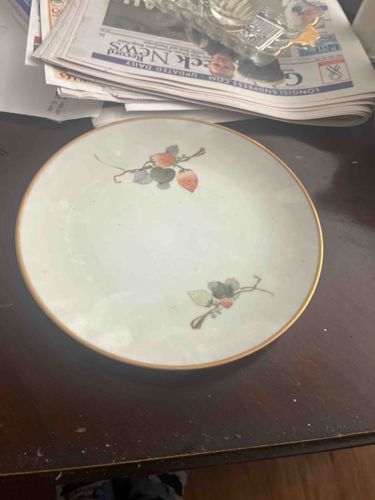
Ceramic Plate with Strawberry Motif
The item is a small ceramic plate, likely a saucer or dessert plate, with a diameter of approximately 6-8 inches. It has a white glaze base color with a visible crazing throughout the surface, indicating age and potential moisture exposure. The rim is adorned with a thin gold band, showing some signs of wear and rubbing. There are two hand-painted motifs on the plate's surface, depicting what appears to be strawberry plants. Each motif features a vine with green and gray leaves, a small red berry, and a cluster of white or light orange flowers or unripe berries. The painting is somewhat stylized, with a watercolor-like effect. There are no visible maker's marks, signatures, or stamps on the surface of the plate or its bottom. Based on the style of the decoration and the presence of crazing, it is likely an older piece, possibly from the early to mid-20th century. The craftsmanship appears to be of a moderate quality, consistent with mass-produced or semi-handcrafted dinnerware of that period. There are no apparent chips or cracks, but the crazing is a significant condition issue.
AI-Generated Appraisal Disclaimer
Estimated Value
$10-20
Basic Information
Category
Dinnerware
Appraised On
December 7, 2025
Estimated Value
$10-20
Item Description
The item is a small ceramic plate, likely a saucer or dessert plate, with a diameter of approximately 6-8 inches. It has a white glaze base color with a visible crazing throughout the surface, indicating age and potential moisture exposure. The rim is adorned with a thin gold band, showing some signs of wear and rubbing. There are two hand-painted motifs on the plate's surface, depicting what appears to be strawberry plants. Each motif features a vine with green and gray leaves, a small red berry, and a cluster of white or light orange flowers or unripe berries. The painting is somewhat stylized, with a watercolor-like effect. There are no visible maker's marks, signatures, or stamps on the surface of the plate or its bottom. Based on the style of the decoration and the presence of crazing, it is likely an older piece, possibly from the early to mid-20th century. The craftsmanship appears to be of a moderate quality, consistent with mass-produced or semi-handcrafted dinnerware of that period. There are no apparent chips or cracks, but the crazing is a significant condition issue.
Related Tags
Get Your Items Appraised
Instant estimates of your treasures with AI-powered instant appraisals